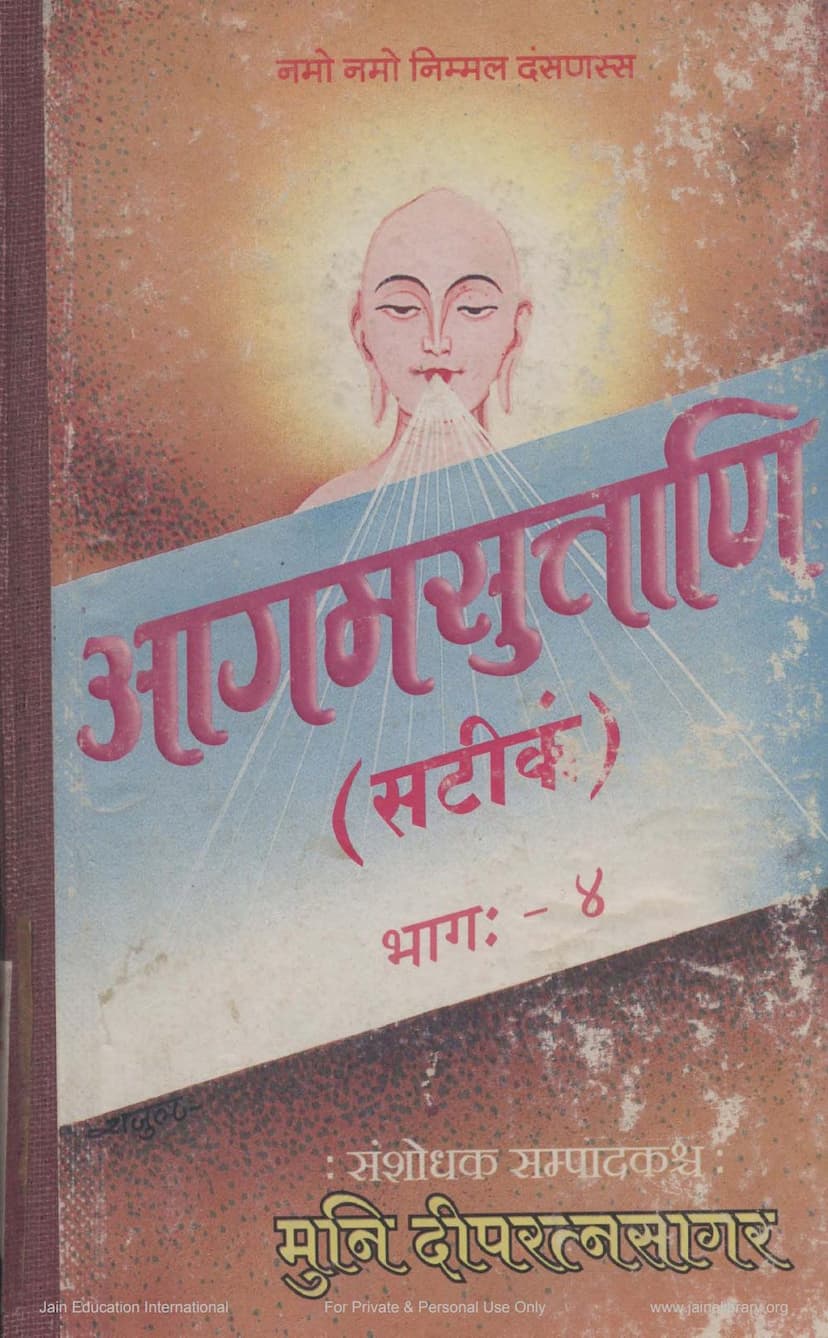Agam Suttani Satikam Part 04 Samavayang
Added to library: September 1, 2025

Summary
Here's a comprehensive summary of the Jain text "Agam Suttani Satikam Part 04 Samavayang," based on the provided pages:
Book Title: Agam Suttani Satikam Part 04 Samavayang Author(s): Dipratnasagar, Deepratnasagar (Munishri Deepratnasagarji) Publisher: Agam Shrut Prakashan Catalog Link: https://jainqq.org/explore/003308/1
Overview:
This volume, Part 4 of the "Agam Suttani Satikam" series, presents the Samavayang Sutra, which is the fourth Anga (limb) of the Jain Agamas. The work is a critical edition and commentary (Satikam) by Muni Deepratnasagar. The primary purpose of the Samavayang Sutra, as indicated by its name, is to classify and enumerate various categories of Jain doctrine, often in a numerical fashion. It lists and explains concepts, entities, and phenomena, frequently in ascending numerical order, starting from one and progressing through higher numbers.
Content and Structure:
The provided pages outline the structure of the Samavayang Sutra through its detailed Vishayanukram (Table of Contents). This index meticulously lists each "Samavaya" (section or chapter) with its corresponding starting page number and a "Moolanka" (root number or identifier).
- The book starts with invocations: Pages 1-2 contain dedications and auspicious beginnings, including reverence to deities, gurus, and the tradition of Jain Agam literature. The publication details and contact information are also present.
- Comprehensive Table of Contents (Vishayanukram): Pages 3-4 present a vast table of contents, enumerating 383 "Samavayas." Each Samavaya is a numerical category, detailing a specific number of items related to a concept. The index covers Samavayas from 1 up to 383, listing the topic or category being enumerated.
- The Samavaya itself begins: Pages 5 onwards start the actual content of the Samavayang Sutra, with an introduction and the first Samavaya.
- Introduction: It explains the significance of the Samavaya as the fourth Anga, its relationship to the previous Anga (Sthananga), and its purpose: to present a classified and organized exposition of Jain principles. The introduction highlights that the text was spoken by Lord Mahavir to his disciple Jambunatha, as narrated by Ganadhara Shudharma-swami.
- First Samavaya (Samavaya-1): This section begins with fundamental dichotomies (e.g., one soul, one non-soul; one law, one un-law). It then proceeds to enumerate various entities and concepts numerically, such as:
- Units: One soul, one non-soul, one law, one un-law, one heaven, one hell, etc.
- Cosmological Details: The dimensions of Jambudvipa (one hundred thousand yojanas), hells, and the highest heaven (Siddhashila) are mentioned.
- Lifespans: It starts detailing the lifespans of various beings in different realms, beginning with one Palyopama and one Sagaropama.
- Other Classifications: The text will likely continue to enumerate various aspects of Jain cosmology, karma, soul, deities, hell beings, human lifespans, Jain practices, and philosophical concepts, typically in numerical sequences.
Commentary (Satikam):
The presence of "Satikam" in the title and the commentary provided by Muni Deepratnasagarji indicate that this volume offers a detailed explanation and interpretation of the original Samavayang Sutra text. The commentary helps clarify the meaning of the Sutra's verses and the classification of concepts. The example commentary for the first Samavaya elaborates on the meaning of terms like "Samavaya" and the attributes of Lord Mahavir.
Key Themes and Purpose of Samavayang Sutra:
- Classification and Enumeration: The primary function is to systematically list and categorize Jain doctrines and entities.
- Numerical Progression: It uses numerical order to present concepts, aiding in memorization and comprehension.
- Cosmology and Ontology: It details the structure of the universe (Jambudvipa, hells, heavens), lifespans of beings, and the nature of reality.
- Doctrinal Exposition: It systematically explains core Jain philosophical tenets like soul, non-soul, karma, liberation, and the path to it.
- Systematic Knowledge: By presenting knowledge in a structured, numerical format, it aims to provide a comprehensive overview of the Jain worldview.
Significance:
The Samavayang Sutra is crucial for understanding the systematic classification and breadth of Jain knowledge. It serves as a reference text that enumerates and organizes the multifaceted aspects of the Jain tradition, making complex doctrines more accessible through its structured approach. The commentary by Muni Deepratnasagarji further enhances its accessibility and depth for students and practitioners of Jainism.